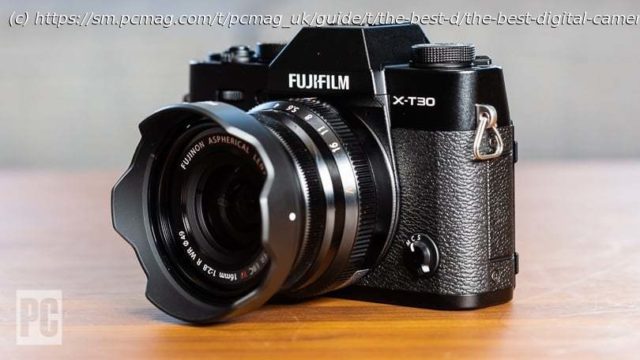We test and rate scores of digital cameras and lenses each year, from pocket-friendly models to high-end medium format systems. Here’s everything you need to know to pick the best camera for you.
Which Point-and-Shoot Camera Has the Best Image Quality?
It’s no secret that smartphones have seriously hurt the demand for entry-level point-and-shoot cameras. The latest from Apple, the iPhone 15, is a better camera than any low-cost compact, and Android fans can get excellent snapshots with handsets like the Samsung Galaxy S23 or the Google Pixel 7. High-end phones are expensive, but if you’re already buying a fancy handset, there’s no reason to buy a low-end camera, too. If you’ve embraced smartphone photography, peruse our top camera phone picks to help find your next phone and check out our tips for taking the best smartphone photos.
If you aren’t a smartphone user or have opted to go for a basic model without a high-end camera, you can buy any number of sub-$100 no-name cameras at online retailers, but I’d avoid them like the plague. If you can spend more than $100, we recommend you stick with Canon, Nikon, Panasonic, and Sony.
Most sub-$200 cameras stand apart from smartphones because they pack decent zoom power, though they largely rely on older CCD sensor technology. The 20MP CCD sensors common across the current generation offer plenty of resolution, but suffer in dim light and top out at 720p video quality.
If you stretch your budget up to $400, you can find cameras with more modern CMOS image sensors and longer zoom lenses—30x is the standard at this point. 1080p video is common, and you often get small electronic viewfinders, Raw shooting options, and quick autofocus. Pure image quality isn’t any better than a midrange smartphone though; the zoom lens is the main advantage.Which Camera Is Best for Underwater Use?
A rugged, waterproof camera is a good option if you’re an outdoor adventurer, snorkeler, beachgoer, or just a bit of a klutz. For around $550, the OM System TG-7 is the best you can get, even though you’re paying more for its tough frame and sacrificing picture quality versus a smartphone. If you don’t want to spend that much, you can get a Ricoh WG-80 for under $300. We break down our favorite waterproof cameras in a separate story.
You can also go the action cam route. You get far better video and quality still images from the GoPro Hero12 Black or DJI Osmo Action 4, but you give up zoom power in the process. It’s a trade-off you might want to make, especially if you’re interested in slow-motion video. For more, click through to see our favorite action cams.Small Camera, Big Sensor: The Best Premium Compacts
You might scratch your head when you see pocket cameras with fixed lenses selling for anywhere from $400 to $1,300. After all, you can get an interchangeable lens model for the same price. But these slim, premium shooters target a very specific market—photographers who already own a mirrorless camera or SLR and a bunch of lenses, but want something small as an alternative.
Pocket cameras with Type 1 (also called 1-inch class) sensors compete with iPhones on image quality, offer some zoom power, and have sounder ergonomics for handheld photography. These models dominate our top point-and-shoot list.
Canon, Panasonic, and Sony sell compacts with Type 1 sensors. The Canon G7 X Mark III and G5 X Mark II are our current favorites but are often hard to find in stock. Recent Sony RX100 models are more readily available and are good picks for photography, or you can go for a ZV series for a more video-oriented design.
Some enthusiast-oriented models pair even bigger sensors (from Micro Four Thirds up to full-frame) with a quality prime lens. The Fujifilm X100V is the best of the bunch and one of the few compacts available with a big optical viewfinder. Unfortunately, it’s not often in stock and commands higher than retail prices on the secondary market.
Its competitors vary greatly in concept and form. The Ricoh GR III and IIIx are built for urban documentary imaging, with ergonomics titled for one-handed operation and a snapshot focus mode for focus-free imaging.
And we can’t forget to mention the Leica Q2 Monochrom, one of the few digitals out there with a sensor solely for black-and-white imaging, or the Q3 and its color sensor. These aren’t big tent cameras, but it can be rewarding to stray from the beaten path.Zoom in Close: Is a Bridge Camera Worth It?
You can opt for a fixed-lens camera that’s similar in size and shape to an SLR—a bridge camera. These models tend to have really long lenses—the Nikon P1000 has the most optical zoom power (125x). Long lenses require some extra care to use, so these cameras usually include an eye-level EVF, a hot shoe to mount accessories, and an articulating display.
Bridge models might look like interchangeable lens cameras, but typically don’t do well in dim light.






